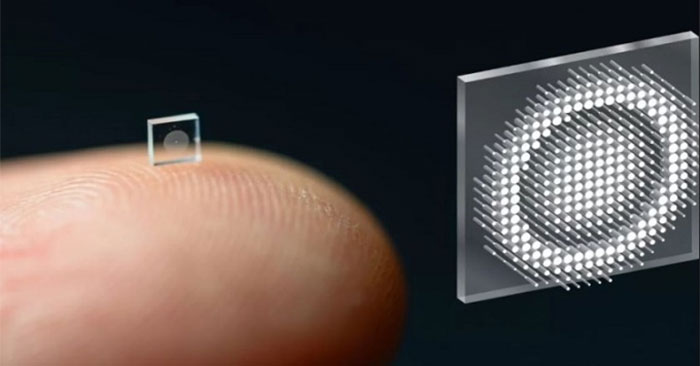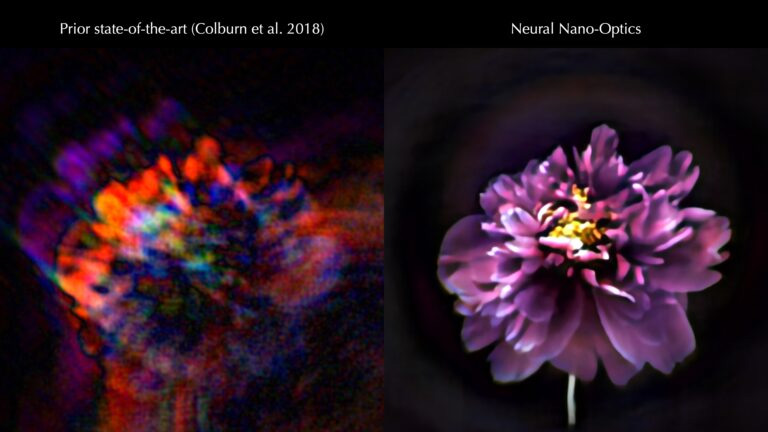Camera the size of a grain of salt, takes amazingly sharp photos
This tiny camera was developed by researchers from Princeton University and the University of Washington, USA. This camera, which is only the size of a grain of salt, can take amazing pictures.
This new tiny camera can capture close-up objects in stunning detail, sharper and more colorful than conventional lenses 500,000 times larger. To achieve this feat, researchers equipped the new tiny camera with a technology called metasurfaces.
This system promises to be the future of medical diagnosis and treatment, allowing minimally invasive endoscopy with medical robots; while also improving imaging for other microrobots.

While traditional cameras use a curved lens—made of glass or plastic—to bend light rays into focus, the new optical system relies on a technology called a metasurface, which can be manufactured like a computer chip. Just half a millimeter wide, the metasurface is embedded with 1.6 million cylinders, each roughly the size of a human virus.
Each pillar has a unique geometry and acts like an optical antenna. The design of each pillar is essential, as it is used to precisely shape the entire optical wavefront. With the help of machine learning-based algorithms, the interactions of the pillars with light are combined - to produce the highest quality images and the widest field of view of a full-color metasurface camera developed to date.
In the past, there were also micro cameras, but the images captured were blurry, fuzzy and inaccurate.

A key innovation in the camera's creation was the integrated design of the optical surface and the signal processing algorithms that generate the images. " This increased the camera's performance in natural light conditions, as opposed to previous metasurface cameras that required pure laboratory laser light or other ideal conditions to produce high-quality images ," said Felix Heide, lead author of the study.
The researchers compared the images produced by their system to those from previous metasurface cameras, and to images captured by a conventional camera with six refractive lenses. Aside from some blurriness at the edges of the frame, the nano-sized camera's images were comparable to those from a traditional lens, which was more than 500,000 times larger.
Currently, researchers continue to look for ways to improve camera image quality, improve object detection technology, and other sensing methods.
The researchers reported their findings in a paper published on November 29, 2021, in the journal Nature Communications. You can read the full paper on the tiny camera here: https://www.nature.com/articles/s41467-021-26443-0
You should read it
- How to clean the selfie camera
- Review the Raspberry Pi V2 camera
- Model of Fujifilm surveillance camera with the ability to zoom in and out of a person from more than 2km away
- Future high-end Nokia phones may have 5 cameras
- Breakthrough AI chip processes at the speed of light, as small as a grain of salt
- Create shortcuts for front and back cameras on Galaxy S9
 Microsoft officially closes online movie and TV store
Microsoft officially closes online movie and TV store Many advanced AI models surpass humans in emotional intelligence, opening up new directions in education and training.
Many advanced AI models surpass humans in emotional intelligence, opening up new directions in education and training. Breakthrough mathematical technology helps determine location without revealing personal information
Breakthrough mathematical technology helps determine location without revealing personal information Snipping Tool finally supports GIF files
Snipping Tool finally supports GIF files Xiaomi Xring 01 benchmark results on Antutu are disappointing: 13% lower than advertised, losing to both Snapdragon and Dimensity
Xiaomi Xring 01 benchmark results on Antutu are disappointing: 13% lower than advertised, losing to both Snapdragon and Dimensity More than 394,000 Windows computers infected with data-stealing Lumma malware
More than 394,000 Windows computers infected with data-stealing Lumma malware